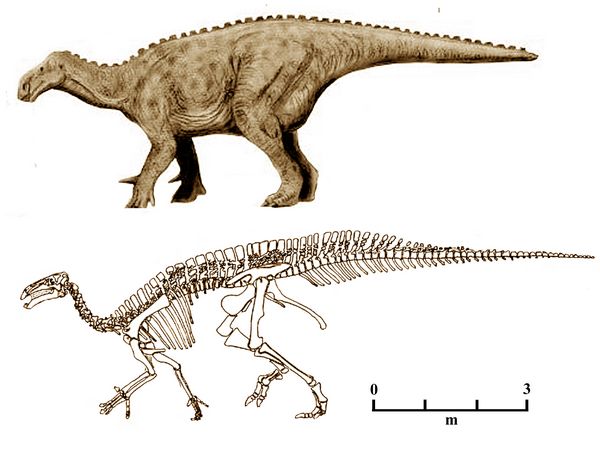Athena Review Image Archive ™
Iguanodon bernissartensis skeleton

Skeleton of Iguanodon bernissartensis (after )
Iguanodon
bernissartensis was
a large plant-eating dinosaur, widespread in Asia, North America, and
Europe during a two million-year interval at the end of the Jurassic
and start of the Cretaceous periods (126-124 mya).
The genus Iguanodon ("iguana tooth") is currently identified within the larger group Iguanodontia, along with the duck-billed hadrosaurs. The type species Iguanodon bernissotensis is named for a site in Belgium where many well-preserved specimens were found starting in the 1880s.
The earliest iguanodon fossils were found in 1822 by Gideon Mantell, who discovered the first fossil Iguanodon teeth, and eventually found much of its skeleton. Mantell (1825) originally identified that the teeth of Iguanodon were similar to those of a herbivorous reptile such as the Iguana (hence the genus name he selected).
The Iguanodon
skull was long and narrow, with a projecting keratin beak. The
upper jaw held up to 29 chisel-like teeth per side, lacking any at the
front of the jaw; while the lower jaw had 25 teeth meeting the upper
teeth, but broader. Because the reptilian teeth were continually
replaced, Iguanodon could eat tough plant material such as tree leaves and grasses.
Eventually,
Mantell acquired enough skeletal evidence to show that Iguanodon's
forelimbs were much shorter than its hindlimbs, and that it might have
been partly bipedal, an essential trait in terms of both foraging and
moving about. Owen, however, had believed it to have been a stumpy,
mammal-like creature with four thick legs, and so reconstructed
Iguanodon at the British Museum. Mantell's findings of Iguanadon leg
bones served to refute Owen's belief. Mantell also demonstrated
that fossil vertebrae, which Owen had attributed to a variety of
different species, all belonged to Iguanodon.
With the 1880s
discovery of complete Iguanodon skeletons at Bernissart, Mantell's view
was fully vindicated, as its semi-bipedal nature was verified. Iguanodon
rested and walked mainly on its four legs, but could stand up to forage
for food. With a body length of about 10 meters, it was up to 4-5
meters high, and could eat eat food ranging from ground plants to tree
foliage.
The digits of Iguanodon's
feet and hands were specialized. The feet had three
elongated digits with claws, making Iguanodon one of the group of
ornithopods, "bird feet," as distinguished from another major group,
the sauropods, or "lizard feet." Its hand (manus), meanwhile,
retained the
primitive tetrapod trait of 5 digits, but with specializations. The
three central fingers were strong and capable of bearing the body's
weight, while the first and fith fingers were specialized.
References:
Copyright © 1996-2020 Rust Family Foundation (All Rights Reserved).